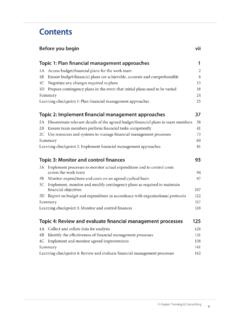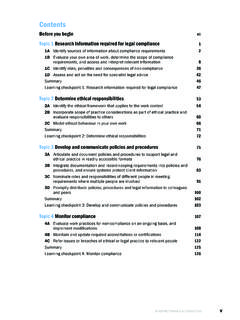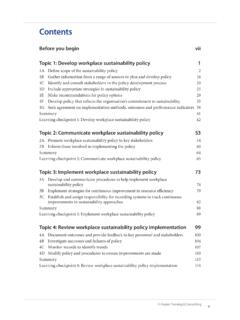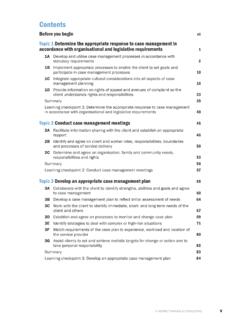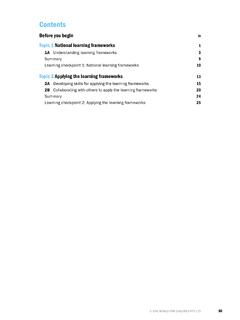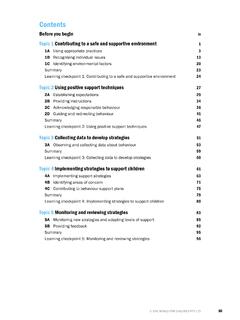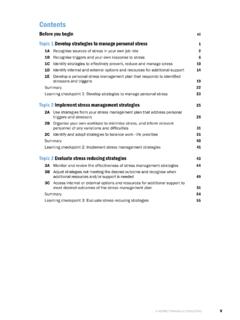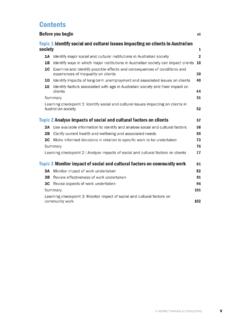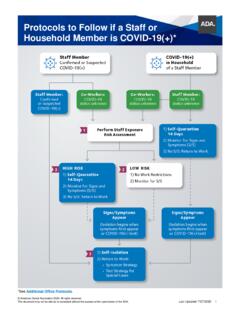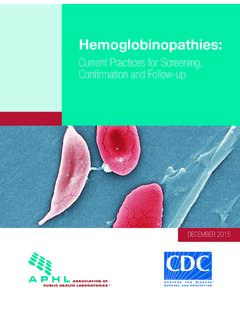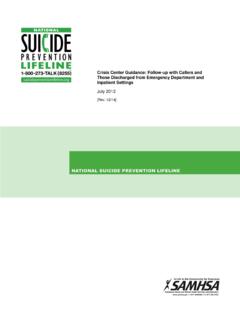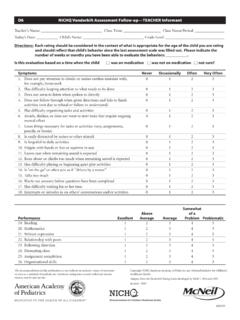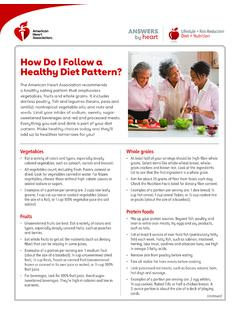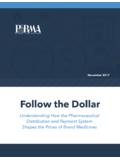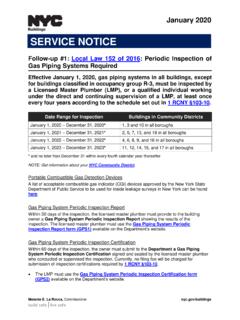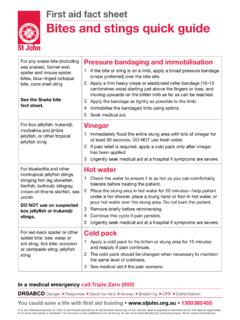Transcription of HLTWHS002 Follow safe work practices for direct client care
1 Contents Before you begin vii Topic 1 Follow safe work practices for direct client care 1. 1A Follow workplace policies and procedures for safe work practices 2. 1B Identify hazards then report and record in accordance with workplace procedures 10. 1C Identify client -related risk factors or behaviours of concern, report and record in accordance with workplace procedures 22. 1D Follow workplace policies and procedures to minimise risk 31. 1E Identify and report incidents and injuries in accordance with workplace procedures 38. Summary 43. Learning checkpoint 1: Follow safe work practices for direct client care 44. Topic 2 Follow safe work practices for manual handling 53. 2A Follow manual handling procedures and work instructions to minimise manual handling risk 54. 2B Identify manual handling hazards and report in line with workplace procedures 57. 2C Apply control measures to minimise manual handling risk 61.
2 Summary 65. Learning checkpoint 2: Follow safe work practices for manual handling 66. Topic 3 Follow safe work practices for infection control 71. 3A Routinely Follow standard precautions to prevent the spread of infection 72. 3B Recognise situations when additional infection control procedures are required 77. 3C Apply additional precautions when standard precautions alone may be insufficient to prevent transmission of infection 80. 3D Identify and report risks of infection in accordance with workplace procedures 84. Summary 87. Learning checkpoint 3: Follow safe work practices for infection control 88. Topic 4 Contribute to safe work practices in the workplace 93. 4A Raise WHS issues with designated persons in accordance with organisational procedures 94. 4B Participate in workplace safety meetings, inspections and consultative activities 97. 4C Contribute to the development and implementation of safe workplace policies and procedures 102.
3 Summary 109. Learning checkpoint 4: Contribute to safe work practices in the workplace 110. v HLTWHS002 Follow safe work practices FOR direct client care . WHS policy and procedures These usually include important information regarding: XX personal protective clothing and equipment XX standard and safety precautions XX handling hazardous/dangerous materials and goods, including completing safety data sheets (SDSs). XX emergency procedures XX standard housekeeping XX hazard identification and control systems XX manual handling XX staff development and training programs XX waste management XX WHS personnel. Personal protective equipment procedures You may be required to wear personal protective equipment (PPE) to perform some aspects of your work . PPE is clothing and equipment designed to protect workers from direct exposure to blood, body fluids, potentially infectious materials and other harmful agents in the work environment.
4 Your WHS policies and procedures and/. or your supervisor will provide information on the use of PPE. Your workplace must provide all essential PPE and ensure it is ready for use at all times. Workers must use PPE correctly to protect their own health and safety. Your supervisor must be notified immediately if PPE requires repair or replacement. Using PPE to eliminate or reduce risks to health and safety is a last resort. PPE. should only be used when particular risks cannot be eliminated or reduced. Standard precaution procedures You may be required to Follow workplace precautionary procedures; for example, you may adopt standard precautionary work practices for infection control such as correct hand-washing techniques. These precautions may be developed according to the recommendations presented in the National Health and Medical Research Council's Australian Guidelines for the Prevention and Control of Infection in Healthcare (2010).
5 At: The Department of Health also publishes a number of resources relating to infection control at: au/internet/ management-infection-control. WHS legislation and regulations Workers have an obligation to keep themselves and others safe at work and must plan their work with these obligations in mind. You need to read, know and understand your WHS policies and procedures. For their part, employers have a more significant and extensive obligation to provide a safe place of work for employees. More information is provided here. 4 ASPIRE TRAINING & CONSULTING. Topic 1 Follow safe work practices for direct client care effective control measures as they are most familiar with the work environment. In addition, an organisation will have in place risk control measures as part of a hierarchy of control. The hierarchy of control is a framework for prioritising the implementation of the most effective and reliable measures, starting with the goal of eliminating a hazard at the source.
6 Risk controls can include: XX policies to influence behaviour; for example, a no-lift policy XX practices to guide the use of equipment XX design to reduce risk; for example, a reception area providing physical protection for staff XX elimination of risk; for example, removing branches of trees that overhang walkways XX signage to warn people of risk; for example, wet floor' signs. Hierarchy of control The most effective risk control measure removes a hazard completely, eliminating the risk at its source. Where this is not possible risk minimisation measures are implemented. The hierarchy of control is a set of levels or choices listed in a preferred order, starting with the best choice (eliminate the risk) and ending with the final choice. You should always eliminate risks if possible. If the risk can't be eliminated, move to level two, which is the second-best choice. Keep moving down the steps until you find the first step that you can use, if none of the other steps are possible.
7 The following interactivity (adapted from safe work Australia) explains the hierarchy of controls used to control risks in the workplace. Level 1 control Elimination Eliminating the risk at its source should always be the first choice. The source of the risk is the hazard, so this usually means removing hazardous material or abandoning hazardous work practices . For example: XX Clean up a spill straight away to avoid anyone else slipping and falling over and hurting themselves. XX Stop using toxic substances that are not essential to the work . XX Repair or replace equipment. 17. HLTWHS002 Follow safe work practices FOR direct client care . 1C Identify client -related risk factors or behaviours of concern, report and record in accordance with workplace procedures When working in the community service environment it is important to be aware of the risk that other people's behaviour, including those receiving care and their visiting friends and family, may pose to the health and safety of yourself and those in the care environment.
8 Some physical and psychological conditions and stressors can impact the parts of the brain that affect mood, self-control and inhibition as well as mood disturbances and cause people to act in socially unacceptable and frightening ways such as yelling and screaming for no apparent reason, or being physically aggressive. Behaviours of concern can be a source of distress for the person, their loved ones and others observing the person's actions. Prevention is always the preferred response. It is important that you are able to identify, report and record behaviours of concern in accordance with your workplace procedures. work in a home-based environment Working in a home-based environment can involve hazards and risks unique to the home-based environment. This is because the home-environment will not have the environmental design, risk and infection controls, emergency management and security precautions that are inherent to the design of health care facilities.
9 Workers need to be aware of the risks to their personal safety and the safety of others, and also what their rights and responsibilities are to ensure their own safety and the safety of others while working in a home-based environment. Rights and responsibilities of workers and clients Under the WHS legislation every worker has the right to a safe workplace that is, so far as reasonably possible, free of risk or harm to the worker's health and safety. In accordance with WHS laws, employers and workers have a duty of care to ensure their own safety and the safety of others while working in a home-based environment. This can often be challenging when a person receiving care has a right to choose how they live and behave within the safety of their own home. For example a person may usually smoke in their home, leave dirty dishes on the tables and entertain visits from intoxicated family members.
10 However, under WHS legislation if a person enters into an agreement where they receive care within their own home, then they are agreeing to comply with reasonably 22 ASPIRE TRAINING & CONSULTING. HLTWHS002 Follow safe work practices FOR direct client care . The standard infection control precautions that Follow should be used in every home- based environment where services are provided. Standard infection control precautions XX Effective hand hygiene XX Use of PPE. XX Use of aseptic techniques XX safe management of sharps XX Maintain a clean physical environment XX Clean reusable items after each use XX Implement respiratory precautions XX Handle and dispose of waste materials appropriately The musculoskeletal system Support workers need to be aware of potential risk of injury to the musculoskeletal system while working in the home-based environment. The musculoskeletal system is made up of the bones, ligaments and muscles of the body.
